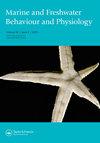The behavioural response of the white-clawed crayfish (Austropotamobius pallipes) to five standard marking techniques over a 14-day period
IF 0.9
4区 生物学
Q3 MARINE & FRESHWATER BIOLOGY
Marine and Freshwater Behaviour and Physiology
Pub Date : 2019-07-04
DOI:10.1080/10236244.2019.1659736
引用次数: 4
Abstract
ABSTRACT The white-clawed crayfish (Austropotamobius pallipes), is classified as endangered in the 2010 IUCN Red List and is protected under Irish and European legislation due to a drastic decline in abundance and range over the past century. Mark-recapture methods play a vital role in the process of estimating population size, and in the monitoring and conservation of mobile species. A variety of marking techniques are routinely used in a range of crayfish species for ecological research. The majority of information on the effects of these marking techniques on the physiology of crayfish species focuses on survivability and growth, whereas information is scarce on the effects on crayfish behaviour. This study investigates the behavioural changes of crayfish in reaction to five commonly used marking techniques in laboratory conditions. The marking techniques used were internal and external passive integrated transponder (PIT) tags, visible implant elastomer (VIE) tags, cauterisation and ablation. Effects of marking technique on behaviour were evaluated immediately after marking, and over a 14-day period, on 78 crayfish. Results indicated that the internal passive integrated transponder (PIT) tags negatively affected crayfish behaviour by increasing resting levels. Ablation and cauterisation also increased grooming levels, while marking reduced activity levels in general. These effects on behaviour occurred immediately after marking, but quickly dissipated. These results suggest that the use of internal PIT tags for marking white-clawed crayfish may need to be avoided as increased resting levels could lead to increased exposure out of refuge and predation. This may have a detrimental impact on the welfare and conservation of white-clawed crayfish and also lead to biased population estimates during mark-recapture projects. The remaining marking techniques (external PIT tag, VIE tag, ablation, cauterisation) may be used, as changes in behaviour will not have a detrimental impact and therefore should not lead to biased population estimates.白爪小龙虾(Austropotamobius pallipes)在14天内对五种标准标记技术的行为反应
白爪小龙虾(Austropotamobius pallipes)在2010年被世界自然保护联盟(IUCN)列为濒危物种,在过去的一个世纪里,白爪小龙虾的数量和范围急剧下降,受到爱尔兰和欧洲立法的保护。标记-再捕获法在估计种群大小、监测和保护流动物种中起着至关重要的作用。各种各样的标记技术通常用于一系列小龙虾物种的生态研究。关于这些标记技术对小龙虾的生理影响的信息大多集中在生存能力和生长方面,而对小龙虾行为的影响的信息很少。本研究调查了小龙虾在实验室条件下对五种常用标记技术的反应行为变化。使用的标记技术是内部和外部被动集成应答器(PIT)标签,可见植入弹性体(VIE)标签,烧灼和消融。在标记后立即评估标记技术对行为的影响,并在14天的时间内对78只小龙虾进行了标记。结果表明,内部被动集成应答器(PIT)标签通过增加静息水平对小龙虾的行为产生负面影响。消融术和烧灼术也增加了梳理水平,同时总体上降低了活动水平。这些对行为的影响在标记后立即发生,但很快就消失了。这些结果表明,可能需要避免使用内部PIT标签来标记白爪小龙虾,因为静息水平的增加可能导致更多的暴露于避难所和捕食者之外。这可能会对白爪小龙虾的福利和保护产生不利影响,并导致在标记-重新捕获项目中对种群的估计有偏差。剩余的标记技术(外部PIT标签,VIE标签,消融,烧灼)可以使用,因为行为的改变不会产生有害影响,因此不应导致有偏差的人口估计。
本文章由计算机程序翻译,如有差异,请以英文原文为准。
求助全文
约1分钟内获得全文
求助全文
来源期刊

Marine and Freshwater Behaviour and Physiology
生物-海洋与淡水生物学
CiteScore
2.10
自引率
0.00%
发文量
9
审稿时长
>12 weeks
期刊介绍:
Marine and Freshwater Behaviour and Physiology is devoted to the publication of papers covering field and laboratory research into all aspects of the behaviour and physiology of all marine and freshwater animals within the contexts of ecology, evolution and conservation.
As the living resources of the world’s oceans, rivers and lakes are attracting increasing attention as food sources for humans and for their role in global ecology, the journal will also publish the results of research in the areas of fisheries biology and technology where the behaviour and physiology described have clear links to the contexts mentioned above.
The journal will accept for publication Research Articles, Reviews, Rapid Communications and Technical Notes (see Instructions for authors for details). In addition, Editorials, Opinions and Book Reviews (invited and suggested) will also occasionally be published. Suggestions to the Editor-In-Chief for Special Issues are encouraged and will be considered on an ad hoc basis.
With the goal of supporting early career researchers, the journal particularly invites submissions from graduate students and post-doctoral researchers. In addition to recognising the time constraints and logistical limitations their research often faces, and their particular need for a prompt review process, accepted articles by such researchers will be given prominence within the journal (see Instructions for authors for details).
 求助内容:
求助内容: 应助结果提醒方式:
应助结果提醒方式:


